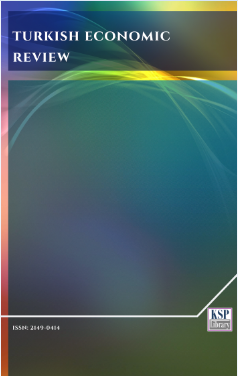Forecasting volatility of gold: Comparison of Turkish gold and equity markets’ risk profile
Abstract
Abstract. Predicting price changes of a commodity thus, forecasting volatility thereof have significant importance for the risk measurement purpose. Perception is that the highly volatile assets overreact more under stressed market conditions, cause excessive volatility and are traded with a discount. In this paper, we evaluated volatility structure of gold and equity markets in Turkey with GARCH volatility modeling methodology, an extended version of ARCH model. Comparison of volatility clustering and overall risk profile of both markets was made. The results show that persistence exists in the volatility process and current conditional volatility of gold prices is significantly impacted by its own past shocks and volatility. The results also confirms the volatility clustering that high volatilities are likely to be pursued by high ones and vice versa in both gold and equity markets. Parallel to literature finding, gold is a diversification instrument because of its low correlation with stock markets and its low risk profile feature induced with low volatilities in gold markets than equity markets.
Keywords. Gold, Equity, Volatility, Risk.
JEL. G10, G11, G15.Keywords
References
Akel, V., & Gazel, S. (2015). Financial market risk and gold investment: The case of Turkey. Çukurova University Social Science Institute Journal, 24(1), 335-350.
Akgiray, V. (1989), Conditional heteroskedasticity in time series of stock returns: Evidence and forecasts, Journal of Business, 62(1), 55-80. doi. 10.1086/296451
Baur D.G., & Lucey B.M. (2010). Is gold a hedge or safe haven? Analysis of stocks, bonds and gold. The Financial Review, 45(2), 217–229. doi. 10.1111/j.1540-6288.2010.00244.x
Baur, D.G., & McDermott, T.K.J (2016). Why is gold a safe haven?. Journal of Behavioral and Experimental Finance, 10, 63-71. doi. 10.1016/j.jbef.2016.03.002
Bollerslev, T. (1986). Generalized autoregressive conditional heteroscedasticity. Journal of Econometrics, 31(3), 307–327. doi. 10.1016/0304-4076(86)90063-1
CBOE GVZ, (2018). Gold Volatility Index, Accessed on Nov. 24. [Retrieved from].
CBOE VIX, (2018). Volatility Index, Accessed on Nov. 24. [Retrieved from].
CBTA, (2018). Electronic data bank, [Retrieved from].
Chiang, S., Lin, C., & Huang, C. (2013). The relationships among stocks, bonds and gold: Safe haven, hedge or neither. Accessed on Nov. 24. [Retrieved from].
Colm, K., & Patton, A.J. (2000). Multivariate GARCH modeling of exchange rate volatility transmission in the European monetary system. The Financial Review, 35(1), 29-48. doi. 10.1111/j.1540-6288.2000.tb01405.x
Costa, F.J.M. (2017). Forecasting volatility using GARCH models. Accessed on Nov. 24. [Retrieved from].
Doğru, B., & Uysal, M. (2015). Analysis of the relationship between gold as an investment instrument and stocks index: An empirical application on Turkey. Çukurova Üniversitesi, Social Science Institute Journal, 24(1), 239-254.
Du, Y. (2012). Modelling and forecasting volatility of gold price with other precious metals prices by univariate GARCH models. Master’s Thesis, Accessed on Nov. 24. [Retrieved from].
Engle, R.F. (1982). Autoregressive conditional heteroscedasticity with estimates of the variance of United Kingdom inflation. Econometrica, 50(4), 987–1007. doi. 10.2307/1912773
Fryzlewicz, P. (2007). Lecture notes: Financial time series, ARCH and GARCH. Accessed on Nov. 24. [Retrieved from].
Ghosh, D., Levin E.J., Macmillan, P., & Wright R.E. (2002). Gold as an inflation hedge. University of St. Andrews, Department of Economics, Discussion Paper Series, No.71. Accessed on 24.08. [Retrieved from].
Ghosh, D., Levin, E.J., Macmillan, P., & Wright, R.E. (2004). Gold as an inflation hedge?. Studies in Economics and Finance, 22(1), 1-25. doi. 10.1108/eb043380
İbicioğlu, M. (2012). Multidimensional scaling analysis of relations among returns of investment instruments, Economic and Soscial Researchs Journal, 8(2), 45-55.
Ibrahim, M.H. (2012). Financial market risk and gold investment in an emerging market: The case of Malaysia. International Journal of Islamic and Middle Eastern Finance and Management, 5(1), 25-34. doi. 10.1108/17538391211216802
Investopedia, (2018). Accessed on Nov. 24. [Retrieved from].
Koutsoyiannis, A. (1983). A short-run pricing model for a speculative asset, tested with data from the gold bullion market. Applied Economics, 15(5), 563-581. doi. 10.1080/00036848300000037
Mishra, P.K., Das, J.R., & Mishra, S.K. (2010). Gold price volatility and stock market returns in India. Accessed on 24.08. [Retrieved from].
Nagayev, R., & Dinç, Y. (2018). Gold as hedge and safe haven: Evidence from Turkey. Journal of Islamic Economics And Finance, 4(1) 1-15.
Özkan, T., & Kolay, Ç. (2016). The empirical analysis of the basic factors effecting the gold market in Turkey. International Conference on Eurasian Economies 2016, Session ID: Finance I, pp.573-582.
Ping, P.Y., Miswan, N.H., & Ahmad, M.H. (2013). Forecasting Malaysian gold using GARCH model. Applied Mathematical Science, 7(58), 2829-2884.
Reboredo, J.C. (2013). Is gold a hedge or safe haven against oil price movements?. Resources Policy, 38(2), 130-137. doi. 10.1016/j.resourpol.2013.02.003
Sinha, P., & Mathur, K. (2016). Linkages between gold futures traded in Indian commodity futures market and international commodity futures market. Accessed Nov 24. [Retrieved from].
Smith, G. (2001). The price of gold and stock price indices for the United States. Accessed on 24.08. [Retrieved from].
Taylor, S.J. (1986). Forecasting the volatility of currency exchange rates. International Journal of Forecasting, 3(1), 159-170. doi. 10.1016/0169-2070(87)90085-9
Tully, E., & Lucey B.M. (2007). A power GARCH examinations of the gold market. Research In International Business And Finance, 21(2), 316-325. doi. 10.1016/j.ribaf.2006.07.001
Wang, P., & Wang, P. (2001). Equilibrium adjustment, bais risk and risk transmission in spot and forward foreign exchange markets. Applied Financial Economics, 11(2), 127-136. doi. 10.1080/096031001750071514
West, K.D., & Cho, D. (1995). The predictive ability of several models of exchange rate volatility, Journal of Econometrics, 69(2), 367-391. doi. 10.1016/0304-4076(94)01654-I
DOI: http://dx.doi.org/10.1453/ter.v6i3.1886
Refbacks
- There are currently no refbacks.
.......................................................................................................................................................................................................................................................................................................................................
Turkish Economic Review - Turk. Econ. Rev. - TER - www.kspjournals.org
ISSN: 2149-0414
Editor: [email protected] Secretarial: [email protected] Istanbul - Turkey.
Copyright © KSP Library




